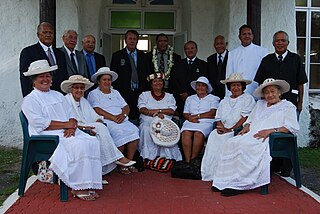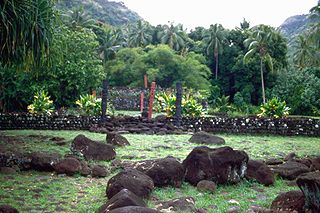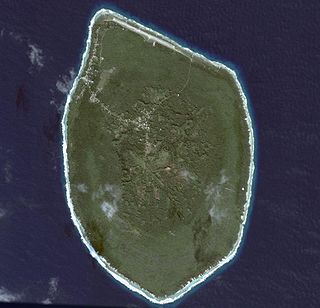Related Research Articles

The politics of the Cook Islands takes place in a framework of a parliamentary representative democracy within a constitutional monarchy. The Monarch of New Zealand, represented in the Cook Islands by the King or Queen's Representative, was the Head of State; the prime minister is the head of government of a multi-party system. The nation is self-governing and are fully responsible for internal and foreign affairs. Since 2001, the Cook Islands has run its own foreign and defence policy. Executive power is exercised by the government, while legislative power is vested in both the government and the islands' parliament. The judiciary is independent of the executive and the legislatures.

Aitutaki, also traditionally known as Araʻura and Utataki, is the second most-populated island in the Cook Islands, after Rarotonga. It is an "almost atoll", with fifteen islets in a lagoon adjacent to the main island. Total land area is 18.05 km2 (6.97 sq mi), and the lagoon has an area of between 50 and 74 km2. A major tourist destination, Aitutaki is the second most visited island of the Cook Islands.

Rarotonga is the largest and most populous of the Cook Islands. The island is volcanic, with an area of 67.39 km2 (26.02 sq mi), and is home to almost 75% of the country's population, with 13,007 of a total population of 17,434. The Cook Islands' Parliament buildings and international airport are on Rarotonga. Rarotonga is a very popular tourist destination with many resorts, hotels and motels. The chief town, Avarua, on the north coast, is the capital of the Cook Islands.

The coat of arms of the Cook Islands has a shield as its focal point. The shield is blue with fifteen white stars arranged in a circle, as found on the national flag, and is supported by a flying fish (maroro) and a white tern (kakaia). The helmet is an ariki head-dress of red feathers, symbolising the importance of the traditional rank system, and the name of the nation is on a scroll below the shield. The achievement is augmented by a cross and a Rarotongan club used by orators during traditional discourses, respectively symbolizing Christianity and the richness of Cook Islands' tradition, placed in saltire behind the shield.

Ngāti Porou is a Māori iwi traditionally located in the East Cape and Gisborne regions of the North Island of New Zealand. Ngāti Porou is affiliated with the 28th Maori Battalion, It also has the second-largest affiliation of any iwi, behind Ngāpuhi with an estimated 92,349 people according to the 2018 census. The traditional rohe or tribal area of Ngāti Porou extends from Pōtikirua and Lottin Point in the north to Te Toka-a-Taiau in the south. The Ngāti Porou iwi also comprises 58 hapū (sub-tribes) and 48 mārae.

Mangaia is the most southerly of the Cook Islands and the second largest, after Rarotonga. It is a roughly circular island, with an area of 51.8 square kilometres (20.0 sq mi), 203 kilometres (126 mi) from Rarotonga. Originally heavily populated, Mangaia's population has dropped by 75% in the last 50 years.

Atiu, also known as Enuamanu, is an island of the Cook Islands archipelago, lying in the central-southern Pacific Ocean. Part of the Nga-pu-Toru, it is 214 km (133 mi) northeast of Rarotonga. The island's population has dropped by two-thirds in the last 50 years.
A mataiapo or mata'iapo is a hereditary chiefly title in the Cook Islands. The head of a sub-tribe, subject to the ariki as far as the whole tribe is concerned and owing him traditional allegiance, but otherwise largely independent as head of his own family group and owning land in his own right.

Rakahanga is part of the Cook Islands, situated in the central-southern Pacific Ocean. The unspoilt atoll is 1,248 kilometres from the Cook Islands' capital, Rarotonga, and lies 1,111 kilometres south of the equator. Its nearest neighbour is Manihiki which is just 44 kilometres away. Rakahanga's area is 4 square kilometres (1.5 sq mi). Its highest point is approximately 5 metres above sea level. The population was 83 in the 2016 Census of Population & Dwellings. Since 2014 Rakahanga's power has been 100% solar generated. The Rakahanga-Manihiki language differs from Cook Islands Maori.

Manihiki is an atoll in the northern group of the Cook Islands known informally as the "Island of Pearls". It is located in the Northern Cook Island chain, approximately 1,299 kilometres (807 mi) north of the capital island of Rarotonga, making it one of the most remote inhabitations in the Pacific Ocean. Its name has two possible meanings: It's believed that the original name of the island was Manuhiki, inspired by the aboriginal discovers Manu coming from the word Rua Manu and Hiki meaning ashore, so the literal translation would be canoe carried ashore. The second interpretation is that the original discoverers were from Manihi, an island in Tuamotus, so the name of the island would mean Little Manihi.

Manuae is an uninhabited atoll in the southern group of the Cook Islands, 100 kilometres south-east of Aitutaki. It is administratively part of Aitutaki, but it does not belong to any district or tapere of Aitutaki. It is, however, part of Arutanga-Reureu-Nikaupara Constituency.
A tribal chief or chieftain is the leader of a tribal society or chiefdom.

The House of Ariki is a parliamentary body in the Cook Islands. It is composed of Cook Islands high chiefs (ariki), appointed by the King's Representative. While it functions in a similar way to the House of Lords and the Senate of Canada, the country's parliament is officially unicameral. There are up to twenty-four members, representing different islands of the Cooks.
An ariki, ꞌariki, aliki, ali‘i, ari'i, aiki or hakaiki, akariki or ‘eiki (Tonga) is or was a member of a hereditary chiefly or noble rank in Polynesia.
A Tapere or Sub-District is a low level of traditional land subdivision on five of the Southern Cook Islands, comparable to the ahupua'a of the main Hawaiian Islands or to the kousapw of Pohnpei. Among the populated raised islands, only Mitiaro is not subdivided into tapere. The remaining Southern Cook Islands, Manuae, Palmerston and Takutea are atolls and/or uninhabited, and therefore not subject to this type of traditional subdivision. The atolls of the Northern Cook Islands are subdivided into motu, instead.

The Arioi or Areoi were a secret religious order of the Society Islands, particularly the island of Tahiti, with a hierarchical structure, esoteric salvation doctrine and cultish and cultural functions. They included both men and women of all social strata, though men predominated. The Arioi principally venerated the war god 'Oro, whom they considered the founder of their order.

The culture of the Cook Islands reflects the traditions of its fifteen islands as a Polynesian island country, spread over 1,800,000 square kilometres (690,000 sq mi) in the South Pacific Ocean. It is in free association with New Zealand. Its traditions are based on the influences of those who settled the islands over several centuries. Polynesian people from Tahiti settled in the Cook Islands in the 6th century. The Portuguese captain, Pedro Fernandes de Queirós, made the first recorded European landing in the islands in the early 17th century, and well over a hundred years later, in the 18th century, the British navigator, Captain James Cook arrived, giving the islands their current name. Missionaries developed a written language, bringing schools and Christianity to the Cook Islands in the early 19th century. Cook Islands Māori, also known as Māori Kūki 'Āirani or Rarotongan, is the country's official language.

Mauke is an island of the Cook Islands archipelago, lying in the central-southern Pacific Ocean. Part of the Nga-pu-Toru, it is 277 km (172 mi) northeast of Rarotonga.
Kau Mapu was a Cook Islands chief, civil servant and politician. He was a member of the Legislative Assembly between 1958 and 1965.
Waikari was a 17th-century Maori ariki or rangatira (chieftain) of Ngāti Tūwharetoa from the region around Lake Taupō, New Zealand. He was one of the leaders in the Ngāti Tūwharetoa invasion of Taupō, fighting against Ngāti Kurapoto and Ngāti Hotu, and Subsequently, he led an attack on Ngāti Apa, who were settled on Lake Rotoaira and was the main leader in the Ngāti Tama-Ngāti Tūwharetoa War, which marked the final consolidation of Tūwharetoa control over the whole of Lake Taupō. He was killed by Ngāti Raukawa rangatira Te Ata-inutai. He probably lived in the late sixteenth and early seventeenth centuries.
References
- ↑ Cook Islands Maori Dictionary, by Jasper Buse, Raututi Taringa (1995) p. 376 Google books
- ↑ The Cook Islands, 1820-1950 by Richard Phillip Gilson, R. G. Crocombe (1980) p. 10 Google books